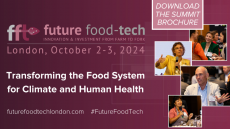What is the role of circularity in a sustainable food system?

When aiming towards a more sustainable food system, many policymakers and innovators view the protein transition, a move away from animal proteins, as an important part of mitigating the affects of climate change (although there is some disagreement over whether this transition is towards a range of alternative proteins, including insects, or simply plant-based proteins).
One organisational principle that has the potential to be used alongside this protein transition, however, is circularity. A food system working on the principles of circularity ensures that waste is avoided wherever possible and the system places efficiency front-and-centre.
A recent study in Nature Food used the Circular Food System (CiFoS), a quantitative tool, to examine the affect of these two approaches on land use and greenhouse gas emissions by examining the impact of two scenarios. While in both scenarios, the composition of people’s diets shifted towards those suggested by the EAT-Lancet diet, in one protein consumption remained at 82g per person per day, while in another it was reduced to the level of 46g per person per day.

How does the protein transition impact climate change?
In Europe at the moment, according to the study, the average person consumes 82g of protein, 49g of which come from animal proteins. While many studies recommend the reduction of animal proteins for a more sustainable food system, not all recommend cutting them out completely.
In the current study, it was found that greenhouse gas emissions and land use are significantly reduced when the ratio between animal protein and plant protein consumption shifts from 60:40 to 40:60, and when animal numbers are significantly reduced.
Why are soybean prices falling?
Soybean prices on the commodity exchange have been steadily decreasing in recent years. This is due to expectations of a significant increase in crop production, which was only slightly reduced by flooding in Brazil’s Rio Grande do Sul state.
At the current intake levels of protein, this means that animal protein consumption is reduced to 33g per person per day, resulting in a land use reduction of 59% and a greenhouse gas emissions reduction of 81%.
Animal protein, with an animal to plant proteins ratio of 40:60 at the recommended lower intake of 46g per person per day, would be 18g per person per day.
When animal protein consumption is reduced to below 18g daily, many face inadequacies in nutrients such as B12 and calcium. Land use would be expected to be significantly expanded in order to grow nutrient-dense crops such as vegetables, legumes, nuts and seeds to make up for the loss of nutrients.

While not included in the main study, the paper briefly suggested that supplementation, fortification and future foods could help mitigate such nutrient inadequacies.
How does circularity impact climate change?
However, the researchers found that the most effective relative reduction of land use and greenhouse gas emissions was brought about by optimising production, consumption and trade towards a circular food system. Even when animal protein consumption stays the same, at a ratio of 60:40 with plant-based protein, circularity is successful.
It was able to reduce land use by 44% and greenhouse gas emissions by 70%. Circularity would be achieved by an improved use of food waste streams such as animal feed (feeding animals on a diet of by-products, crop residues, and food waste), an optimisation of plant and animal production systems, and the reduction of transport use. With a reduction of protein intake to 46g, this became a 58% reduction in land use and a 80% reduction in greenhouse gas emissions.
Cutting down on transportation was a key part of the reduction of greenhouse gas emissions in particular. In the optimal scenario for reducing them, transport only made up less than 5% of total emissions. However, the study pointed out, some transportation is necessary if consumers are to transition to a more plant-based diet.
Climate change threatens commodities
Prices of agricultural commodities have been routinely threatened by unpredictable weather patterns such as increased rainfall (‘sogflation’) and increased heat (‘heatflation’). Some commodities, such as cocoa and potatoes, are particularly vulnerable.
What happens when you combine the two?
Of course, while one may be more effective than the other, both are better. According to the study, implementing circularity principles plus shifting the protein ratio towards a heavier plant-based protein consumption can reduce land use by 60% and greenhouse gas emissions by up to 81%.
The study suggested that reducing the protein intake from 82g per person per day to 46g would not make a significant difference to this.
Sourced From: Nature Food
'Circular food system approaches can support current European protein intake levels while reducing land use and greenhouse gas emissions'
Published on: 28 May 2024
Doi: https://doi.org/10.1038/s43016-024-00975-2
Authors: W. J. Simon, R. Hijbeek, A. Frehner, R. Cardinaals, E. F. Talsma & H. H. E. van Zanten


























